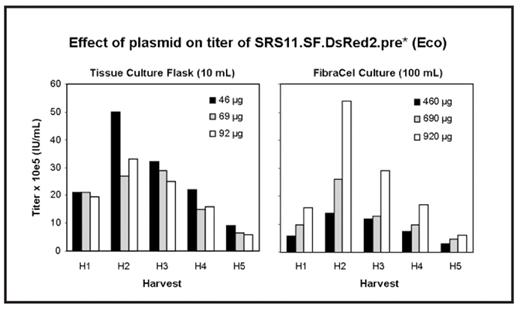Abstract
The need for gamma-retroviral vectors with self-inactivating (SIN) long terminal repeats for clinical trials has prompted a shift in the method with which large scale GMP-grade vectors are produced, from the use of stable producer lines to transient transfection-based techniques. The main challenge of instituting this methodology was to develop SIN retrovirus vectors that produced high amounts of genomic vector RNA in packaging cells, and to design scalable processes for closed system culture, transfection and virus harvest. Using improved expression plasmids, the Vector Production Facility, an academic GMP manufacturing laboratory that is part of the Translational Cores at Cincinnati Children’s Hospital, has developed such a method based on the Wave Bioreactor® production platform. In brief, cells from a certified 293T master cell bank are expanded, mixed with transfection reagents, and pumped into a 2, 10 or 20 Liter Wave Cell Bag containing FibraCel® discs. Cells are cultured in DMEM with GlutaMax® and 10% FBS at 37°C, 5% CO2 at a rocking speed of 22 rpm and 6° angle. At 16–20 hrs post-transfection, the media is changed; virus is harvested at 12-hour intervals, filtered through a leukocyte reduction filter, aliquoted into Cryocyte freezing containers, and frozen at or below −70°C. Several processing parameters, including the confluency of cells harvested prior to transfection, the timing of transfection, the amount of plasmid DNA, exposure of cells to PBS/TrypLESelect, and the timing of the media change post-transfection affected vector titer. Mixing cells with plasmid and transfection mixture prior to seeding onto FibraCel, as compared to transfecting cells 1-day post-seeding (as is standard when using tissue culture plastic) increased the titer from 104 to 4 × 105 IU/mL. Similarly, increasing the amount of plasmid DNA per mL from 4.6 to 9.2 μg doubled the titer in the Wave, while it reduced titer by 20–40% in tissue culture flasks (Fig. 1). Using an optimized protocol, six cGMP-grade SIN gamma-retroviral vectors have now been produced in support of the FDA’s National Toxicology Program (NTP), with unconcentrated vector titers ranging from 1 × 106 to as high as 4 × 107 IU/mL. Using similar processing, we have produced a large scale SIN gamma-retroviral vector (GALV pseudotyped) for an international X-linked SCID trial with average unconcentrated titers of 106 IU/mL in all viral harvests. In summary, the process developed at the Cincinnati Children’s Hospital Vector Production Facility allows for large scale closed-system production of high-titer retroviral vectors for clinical trials using transient transfection.
Disclosures: No relevant conflicts of interest to declare.
Author notes
Corresponding author


This feature is available to Subscribers Only
Sign In or Create an Account Close Modal